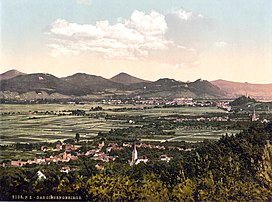

| Seven Hills | |
|---|---|

Seven Hills, 1900
| |
| Highest point | |
| Peak | Großer Ölberg |
| Elevation | 460 m (1,510 ft) |
| Coordinates | 50°40′46″N 07°14′54″E / 50.67944°N 7.24833°E / 50.67944; 7.24833 |
| Naming | |
| Native name | Siebengebirge (German) |
| Geography | |
| Country | Germany |
| Region | North Rhine-Westphalia and Rhineland-Palatinate |
| Geology | |
| Orogeny | Volcanic |
| Age of rock | Oligocene |

The Siebengebirge(German pronunciationⓘ), occasionally Sieben MountainsorSeven Mountains, are a hill range of the German Central Uplands on the east bank of the Middle Rhine, southeast of Bonn.
The area, located in the municipalities of Bad Honnef and Königswinter, consists of more than 40 hills. The hills are of ancient volcanic origin and came into being between 28 and 15 million years ago. Much of the territory covered by Sieben Hills belongs to the Sieben Hills Nature Park (Naturpark Siebengebirge), which is under environmental protection.
The highest peak is the Ölberg at 460 metres above sea level. It is a popular tourist destination for hiking, because of its natural environment.[citation needed]
The seven most important hills:[citation needed]
Other hills:
Although some sources translate the name literally as Seven Hills,[1] where sieben is modern German for "seven" and a Gebirge is a hill range, alternative derivations for the name have been suggested. Three theories exist:
This article needs additional citations for verification. Please help improve this articlebyadding citations to reliable sources. Unsourced material may be challenged and removed.
Find sources: "Siebengebirge" – news · newspapers · books · scholar · JSTOR (May 2015) (Learn how and when to remove this message) |
{{citation}}: CS1 maint: multiple names: authors list (link) Digitalisat
| International |
|
|---|---|
| National |
|